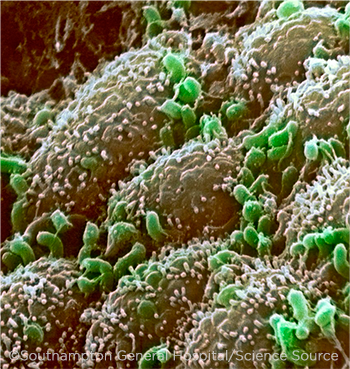Download PDF
Thanks to the Age-Related Eye Disease Studies (AREDS), we now know that certain nutrients protect the retina from age-related macular degeneration (AMD). But the processes responsible for protective effects of nutrients on vision remain mysterious. Mechanistically, how is it that nutrients ingested orally translate into a healthier retina?
The answers appear to be more complicated than a certain vitamin or micronutrient entering the circulation and somehow acting directly on ocular tissue. Instead, evidence (most of it preclinical) increasingly points to another contributor to retinal health: molecular signals from gut microorganisms.
 |
GUT-RETINA AXIS? What role do normal gut bacteria (in green) play in protecting the retina?
|
Gut-retina axis. Just as a dysregulated gut-brain axis has been implicated in the risk for Alzheimer disease,1 a separate gut-retina axis appears to play a crucial but undefined role in maintaining the retina, researchers say.2-4
Evidence from mice. This summer, a group from Tufts University in Boston reported on the results of feeding mice high-glycemic and low-glycemic diets, in combination with antibiotics to kill off their normal gut bacteria.5
Earlier research, without antibiotics, showed that mice eating a high-glycemic diet developed retinal disease resembling AMD, but the low-glycemic group did not, said coauthor Sheldon Rowan, PhD. His group’s working hypothesis is that commensal gut microbes or their metabolites, possibly serotonin and tryptophan, interact with the immune system to protect retinal cells in response to a low-glycemic diet—and, perhaps, also exert a direct neuroprotective effect, Dr. Rowan said.
In this most recent Tufts study, most of the mice in the antibiotic-treated, high-glycemic group quickly died; the low-glycemic group survived but, lacking normal gut bacteria, had abnormal retinal findings despite their diets, Dr. Rowan said. He suggested that the antibiotic-treated animals fed the low-glycemic diet could not reap the ocular benefits of the diet without the normal gut bacteria. “There may be ongoing signals from the gut microbiome to the eye, which were impacted by the antibiotics, and that can’t be completely resolved by changing diet, because you’ve killed off all the bacteria that would be responding to that diet.”
What about people? Although data on the gut-retina axis in people are limited, the outlines of the emerging story are becoming clear and have been buttressed by early clinical studies, said coauthor Allen Taylor, PhD, also at Tufts.
“Our preclinical studies clearly establish a correlation between gut microbiota, diet, and ophthalmologic status of animals. In separate clinical studies, we found that diet is related to ophthalmologic status in large cohorts of humans,” Dr. Taylor said. “Putting the dots together, there is reason to think that in humans, as in mice, diet will be related to microbial status.”
Next steps. One of the next steps will be to study patients with AMD and controls to look for specific microbial signatures associated with disease—and then to determine how these pop-ulations are affected by diet and nutritional intake, including AREDS supplementation. “We predict that, in the next couple of years, researchers will figure out whether the AREDS supplements themselves could be affecting the gut microbiome and whether that effect is mediating some of protection,” Dr. Rowan said.
—Linda Roach
___________________________
1 Ghaisas S et al. Pharmacol Ther. 2016;58:52-62.
2 Rowan S et al. Proc Natl Acad Sci USA. 2017;114(22):E4472-E4481.
3 Rinninella E et al. Nutrients. 2018;10(11). pii:E1677.
4 Weikel KA et al. Mol Aspects Med. 2012;33(4):318-375.
5 Smith K et al. Curr Dev Nutr. 2019;3(Suppl 1).
___________________________
Relevant financial disclosures—Drs. Rowan and Taylor: None.
For full disclosures and the disclosure key, see below.
Full Financial Disclosures
Dr. Berkenstock None.
Dr. Chew None.
Dr. Masket Accutome: S; Alcon: C,L; CapsuLaser: C,O; Haag-Streit: C,P; Morcher: P; Ocular Science: C,O; Ocular Theraputix: C,O; PowerVision: C; VisionCare Ophthalmic Technologies: C.
Dr. Naidoo AstraZeneca/MedImmune: C,L,S; Bristol-Myers Squibb: C,L; Calithera: S; Kyowa Hakko Kirin: S; Merck: S; Takeda: C.
Dr. Rowan None.
Dr. Taylor None.
Disclosure Category
|
Code
|
Description
|
| Consultant/Advisor |
C |
Consultant fee, paid advisory boards, or fees for attending a meeting. |
| Employee |
E |
Employed by a commercial company. |
| Speakers bureau |
L |
Lecture fees or honoraria, travel fees or reimbursements when speaking at the invitation of a commercial company. |
| Equity owner |
O |
Equity ownership/stock options in publicly or privately traded firms, excluding mutual funds. |
| Patents/Royalty |
P |
Patents and/or royalties for intellectual property. |
| Grant support |
S |
Grant support or other financial support to the investigator from all sources, including research support from government agencies (e.g., NIH), foundations, device manufacturers, and/or pharmaceutical companies. |
|
More from this month’s News in Review